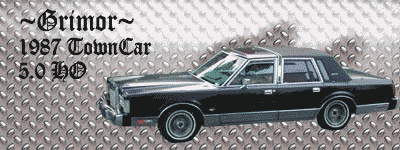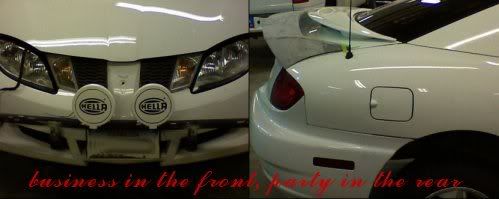Just wondering on opions when it comes to matching amps and speaker ( Subs or components). Is it better to get an amp that's rms is higher, lower or the same as the rms on your subs or components? Any real drawbacks to either one except for the obvious of completely overpowering your subs and blowing them?
IMO...as long as you keep your settings right...you'll be fine with any of the 3. Just depends on how hard you plan on pushing your speakers.
 RE Audio
RE Audio
I'm going to steal this thread somewhat

What would, in general, sound better on a speaker with 300W RMS.
A 300W RMS Amp or one with higher RMS?
Or would there be a difference?



it depends on the amp and the speaker
._____________________________.
Causa latet vis est notissima
 DIY Clear 03+ Headlights
DIY Clear 03+ Headlights
match when you can, overpower when you can't. seal up your speakers so that they have air resistance, you can feed more power to them without them working as hard. and then you have the option of upgrading your speakers in the future without changing out amp racks and such, much easier install. if you hear them clipping TURN IT DOWN!
^^ i thought ports made the sub work less ???
wysiwyg wrote:i would say they bang, they don't really pound so much. but if
you want to bump, then they will bump and hit real hard and a lot good. 
LOL
cuz yeah at lower frequencies the port, if tuned correctly like reinforces the sound waves comin off the woofer itself and actually makes it louder (correct me if im wrong because i read up on that a LONG time ago) and with a sealed box, if your htz go down the subs excursion must increase to maintain the same volume levels...i forget how much but i think its like double the excursion for every 8 htz down ??? ... correct me too cuz i doubt im right, and im always lookin to learn
wysiwyg wrote:i would say they bang, they don't really pound so much. but if
you want to bump, then they will bump and hit real hard and a lot good. 
LOL
Speaker Enclosures
The various combinations of drivers are placed in boxes (enclosures or cabinets) of two basic configurations being the most common.
The sealed box is the simplest configuration, in which the woofer is simply mounted in a box with no other openings. This provides two functions. First, it keeps the output from the back of the driver, which is out of phase from the output of the front of the driver, from the outside of the box, so that the bass doesn't cancel out. Secondly, it provides some additional stiffness for the suspension of the driver, as the internal air acts as a spring when the driver moves back and forth, changing the internal air pressure. Enclosures which provide more stiffness from the internal air than the driver's own suspension are called "acoustic suspension." These are typically small sealed boxes. Enclosures that contribute less stiffness through the internal air pressure than the driver's own mechanical suspension are referred to as "infinite baffle," and are usually on the large side. Most commercially available sealed box designs available today are acoustic suspension, primarily due to the smaller enclosure size.
The second configuration, which is quite common in most mass market products, as well as some high-performance products, is the bass-reflex design. While a sealed box is a single resonant system, a bass-reflex system is two resonant systems, the active driver, and the reflex system. The reflex system works by sucking acoustic output from the rear of the active driver, and then rebounding that energy back out of the cabinet, either through a "port" (a tube) or a passive radiator (has the frame and cone but no voice coil or magnet). These systems can generally deliver more bass extension in terms of their -3 dB cutoff limit everything else being equal, but they also have their drawbacks. The output from the port or passive radiator becomes greatest at the system's tuned frequency, determined by the port dimensions, passive radiators dimensions and weight, and the enclosure volume.
Above the tuned frequency, the port contributes relatively little to the total output, moving more or less in phase with the active driver. As the frequency reproduced moves down to the tuned frequency, the reflex system starts to dominate the output, as it's sucking energy so efficiently from the active driver that while the active driver barely moves, the output from the port or passive radiator may be tremendous. Below the tuned frequency, the output of the port or passive radiator becomes more and more out of phase with the active driver, and more and more equal, so that at lower frequencies, while the driver and the port may be huffing away, it results in very little real SPL, resulting in a much sharper decline in response (24 dB/octave) below the low-frequency cut off than a sealed box (12 dB/octave.) In other words, a bass reflex system can improve bass extension and output to a point, after which it makes it worse. The difference between a port and a passive radiator in terms of performance, generally speaking, are that a port doesn't have any output limitations relating to limited air volume, compared to a passive radiator with a fixed displacement limit. On the other hand, a passive radiator cannot suffer from turbulence noise which afflicts many ported designs.
A variation used in some cases is called "push pull", uses two active (electrically connected to the amplifier) drivers for the pushing and pulling. One driver is mounted inside the non vented box facing outward, and another is mounted outside, facing inward, with the two drivers electrically connected out of phase so that when the cone of one is being driven outward, away from the magnet, the other is being pulled inward, towards the magnet, both being actively driven by the amplifier. Because they're electrically out of phase, AND mechanically out of phase, they're acoustically in-phase. The primary benefit of this arrangement is that even ordered harmonic distortion from each driver is acoustically out of phase, due to the inverted mechanical orientation, and so cancels out, resulting in lower distortion. A secondary benefit, due to the presence of a second driver working in tandem, is an increase in efficiency of roughly 3 dB, assuming the drivers are fairly close to each other, so that two drivers have the potential for four times the output of a single driver. "Push-pull" arrangements can be used with either sealed or bass-reflex designs.
Another trick is to use a "compound pressure" system, sometimes called "isobaric." In essence, this stacks two drivers front to front <>, back to back ><, or back to front >>, essentially using two loudspeakers to operate as one. The outside driver radiates sound, the inside driver pushes on the internal air, and both are coupled to each other with the air between them. The benefits of this are primarily that you can use an internal enclosure of half the size required for a single driver, though the cost is that the efficiency drops to half as well. This is because the two drivers are essentially operating as one, but using just as much power individually. Twice the moving mass, twice the suspension, twice the motor capacity, same surface area and displacement. Bottom line, two drivers, half the box, same output capability, twice the power requirement for the same SPL. However, if the driver are face to face or back to back, and therefore wired out of phase to work at all, the resulting arrangement will be pretty much the same as a push-pull situation in terms of reducing even-order distortion.
Sometimes loudspeaker designs will incorporate a "servo" system, which provides feedback and correction to a driver to lower distortion and assure flat frequency response, much in the same way many amplifier circuits incorporate negative feedback circuits to correct their output by comparing it to their input. Typically, an accelerometer will sit on the voice coil of such a woofer, measure the net force applied to the speaker, which results in motion, subtract the difference from what it's "supposed" to be doing compared to the input signal, invert the difference, and then apply it back to the input signal to offset the error. It does this continually, fairly quickly, so that there isn't much in terms of lag, particularly in the case of subwoofers. Because the accelerometer measures the output of the driver directly, this technique will only work with sealed systems.
And as for the original question, Like already stated by Lash I would have to agree.
you snooze you lose!
keep working, millions on welfare depend on you!
It is always a good idea to have extra available and turn down the gains. Too little power can do more damagae to a sub than having extra in reserve
I'm with stupid!>>>>>>Of coarse, sometimes I feel like turining those arrows the other way and saying I'm stupid!

^^
what do you think happens when you turn the volume down...theres nothin wrong with underpowering...just dont set ur gains high and try to make up for your lack of power
wysiwyg wrote:i would say they bang, they don't really pound so much. but if
you want to bump, then they will bump and hit real hard and a lot good. 
LOL
revvvin87 wrote:Speaker Enclosures
A variation used in some cases is called "push pull", uses two active (electrically connected to the amplifier) drivers for the pushing and pulling. One driver is mounted inside the non vented box facing outward, and another is mounted outside, facing inward, with the two drivers electrically connected out of phase so that when the cone of one is being driven outward, away from the magnet, the other is being pulled inward, towards the magnet, both being actively driven by the amplifier. Because they're electrically out of phase, AND mechanically out of phase, they're acoustically in-phase. The primary benefit of this arrangement is that even ordered harmonic distortion from each driver is acoustically out of phase, due to the inverted mechanical orientation, and so cancels out, resulting in lower distortion. A secondary benefit, due to the presence of a second driver working in tandem, is an increase in efficiency of roughly 3 dB, assuming the drivers are fairly close to each other, so that two drivers have the potential for four times the output of a single driver. "Push-pull" arrangements can be used with either sealed or bass-reflex designs.
Not to thread jack, but how would you make this work?? Like with the amp and such??
-Seth

One sub is wired in reverse polarity (positive from amp to nagative of speaker), the other is wired normally.
-Chris

 RE Audio
RE Audio
